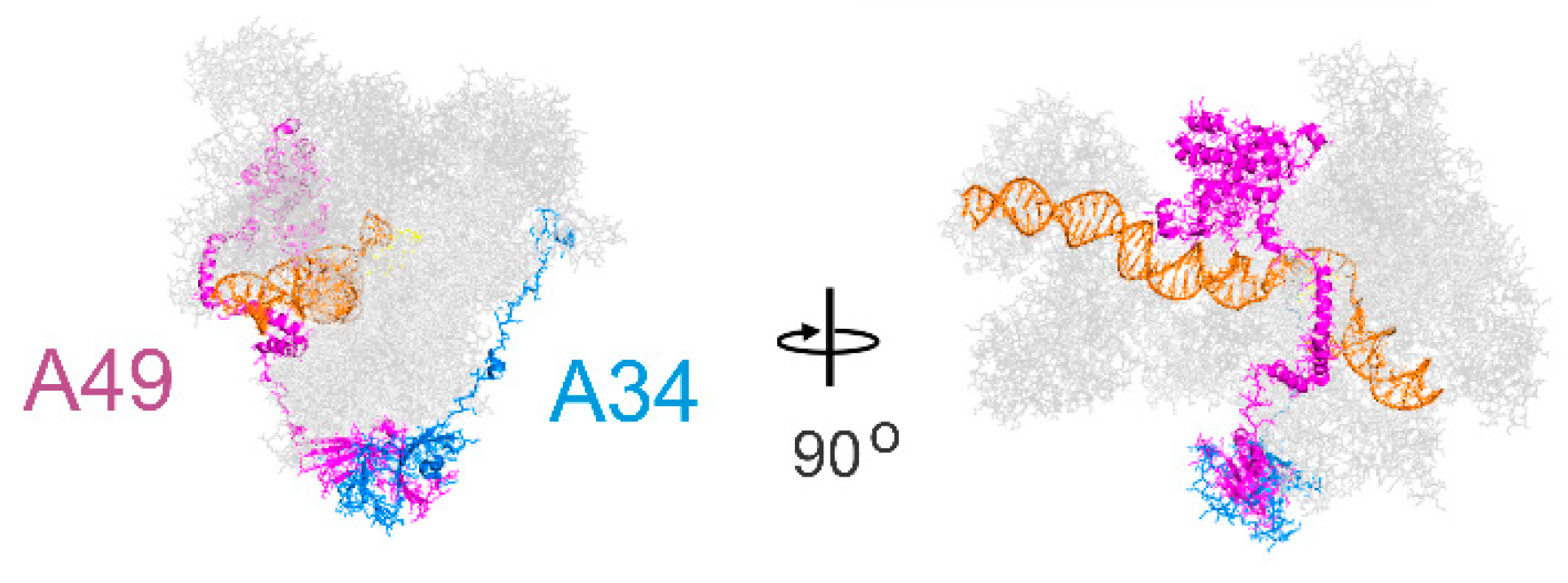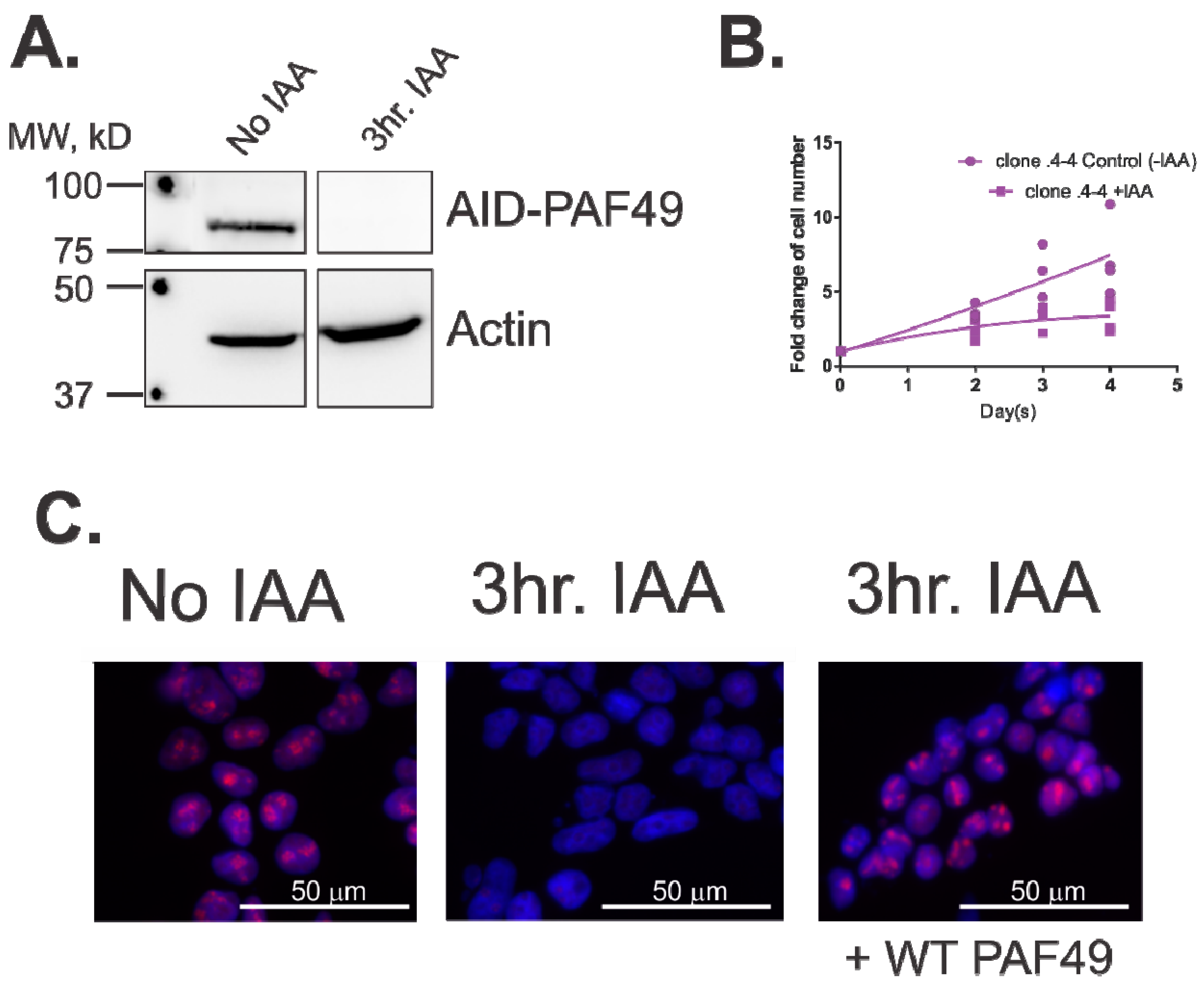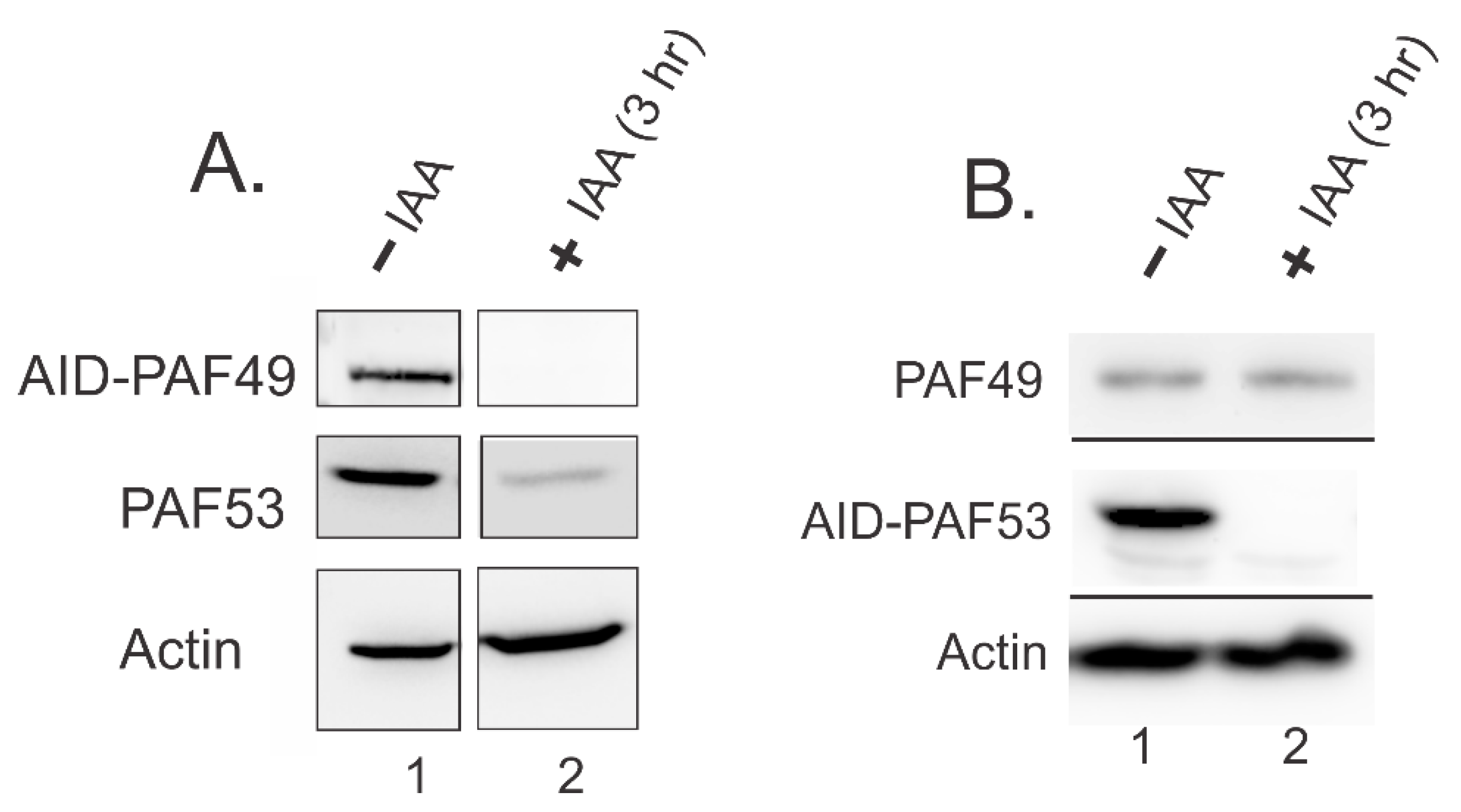The Mammalian and Yeast A49 and A34 Heterodimers: Homologous but Not the Same
Abstract
:1. Introduction
2. The Rpa49 and Rpa34 Protein Families: Mammalian vs. Yeast Heterodimers
2.1. Structure and Sequence
2.2. The PAFs’ Function as a Heterodimer
2.3. Are PAFs Necessary for rDNA Transcription? Cell Growth? Cell Viability?
2.4. What Roles Do PAFs Play during rDNA Transcription?
2.4.1. Promoter Recognition and Initiation
2.4.2. Elongation
2.4.3. Termination
2.5. Regulation of the PAFs
3. Conclusions
Author Contributions
Funding
Institutional Review Board Statement
Informed Consent Statement
Data Availability Statement
Conflicts of Interest
References
- Warner, J.R. The economics of ribosome biosynthesis in yeast. Trends Biochem. Sci. 1999, 24, 437–440. [Google Scholar] [CrossRef]
- Warner, J.R.; Vilardell, J.; Sohn, J.H. Economics of ribosome biosynthesis. Cold Spring Harb. Symp. Quant. Biol. 2001, 66, 567–574. [Google Scholar] [CrossRef]
- Hannan, K.M.; Sanij, E.; Rothblum, L.I.; Hannan, R.D.; Pearson, R.B. Dysregulation of RNA polymerase I transcription during disease. Biochim. Et. Biophys. Acta 2013, 1829, 342–360. [Google Scholar] [CrossRef] [Green Version]
- Danilova, N.; Gazda, H.T. Ribosomopathies: How a common root can cause a tree of pathologies. Dis. Model. Mech. 2015, 8, 1013–1026. [Google Scholar] [CrossRef] [PubMed] [Green Version]
- Tiku, V.; Antebi, A. Nucleolar Function in Lifespan Regulation. Trends Cell Biol. 2018. [Google Scholar] [CrossRef] [PubMed]
- Hannan, K.M.; Hannan, R.D.; Smith, S.D.; Jefferson, L.S.; Lun, M.; Rothblum, L.I. Rb and p130 regulate RNA polymerase I transcription: Rb disrupts the interaction between UBF and SL-1. Oncogene 2000, 19, 4988–4999. [Google Scholar] [CrossRef] [PubMed] [Green Version]
- Hannan, K.M.; Kennedy, B.K.; Cavanaugh, A.H.; Hannan, R.D.; Hirschler-Laszkiewicz, I.; Jefferson, L.S.; Rothblum, L.I. RNA polymerase I transcription in confluent cells: Rb downregulates rDNA transcription during confluence-induced cell cycle arrest. Oncogene 2000, 19, 3487–3497. [Google Scholar] [CrossRef] [Green Version]
- Arabi, A.; Wu, S.; Ridderstrale, K.; Bierhoff, H.; Shiue, C.; Fatyol, K.; Fahlen, S.; Hydbring, P.; Soderberg, O.; Grummt, I.; et al. c-Myc associates with ribosomal DNA and activates RNA polymerase I transcription. Nat. Cell Biol. 2005, 7, 303–310. [Google Scholar] [CrossRef]
- Penrod, Y.; Rothblum, K.; Cavanaugh, A.; Rothblum, L.I. Regulation of the association of the PAF53/PAF49 heterodimer with RNA polymerase I. Gene 2014. [Google Scholar] [CrossRef] [Green Version]
- Cavanaugh, A.H.; Hirschler-Laszkiewicz, I.; Hu, Q.; Dundr, M.; Smink, T.; Misteli, T.; Rothblum, L.I. Rrn3 phosphorylation is a regulatory checkpoint for ribosome biogenesis. J. Biol. Chem. 2002, 277, 27423–27432. [Google Scholar] [CrossRef] [Green Version]
- Fath, S.; Milkereit, P.; Peyroche, G.; Riva, M.; Carles, C.; Tschochner, H. Differential roles of phosphorylation in the formation of transcriptional active RNA polymerase I. Proc. Natl. Acad. Sci. USA 2001, 98, 14334–14339. [Google Scholar] [CrossRef] [Green Version]
- Blank, M.F.; Chen, S.; Poetz, F.; Schnolzer, M.; Voit, R.; Grummt, I. SIRT7-dependent deacetylation of CDK9 activates RNA polymerase II transcription. Nucleic Acids Res. 2017, 45, 2675–2686. [Google Scholar] [CrossRef]
- Russell, J.; Zomerdijk, J.C. The RNA polymerase I transcription machinery. Biochem. Soc. Symp. 2006, 203–216. [Google Scholar]
- Aprikian, P.; Moorefield, B.; Reeder, R.H. New model for the yeast RNA polymerase I transcription cycle. Mol. Cell. Biol. 2001, 21, 4847–4855. [Google Scholar] [CrossRef] [PubMed] [Green Version]
- Huet, J.; Buhler, J.M.; Sentenac, A.; Fromageot, P. Dissociation of two polypeptide chains from yeast RNA polymerase A. Proc. Natl. Acad. Sci. USA 1975, 72, 3034–3038. [Google Scholar] [CrossRef] [PubMed] [Green Version]
- Tower, J.; Sollner-Webb, B. Transcription of mouse rDNA is regulated by an activated subform of RNA polymerase I. Cell 1987, 50, 873–883. [Google Scholar] [CrossRef]
- Schwartz, L.B.; Roeder, R.G. Purification and subunit structure of deoxyribonucleic acid-dependent ribonucleic acid polymerase I from the mouse myeloma, MOPC 315. J. Biol. Chem. 1974, 249, 5898–5906. [Google Scholar] [CrossRef]
- Matsui, T.; Onishi, T.; Muramatsu, M. Nucleolar DNA-dependent RNA polymerase from rat liver. 2. Two forms and their physiological significance. Eur. J. Biochem. 1976, 71, 361–368. [Google Scholar] [CrossRef]
- Hanada, K.; Song, C.Z.; Yamamoto, K.; Yano, K.; Maeda, Y.; Yamaguchi, K.; Muramatsu, M. RNA polymerase I associated factor 53 binds to the nucleolar transcription factor UBF and functions in specific rDNA transcription. EMBO J. 1996, 15, 2217–2226. [Google Scholar] [CrossRef]
- Yamamoto, K.; Yamamoto, M.; Hanada, K.; Nogi, Y.; Matsuyama, T.; Muramatsu, M. Multiple protein-protein interactions by RNA polymerase I-associated factor PAF49 and role of PAF49 in rRNA transcription. Mol. Cell. Biol. 2004, 24, 6338–6349. [Google Scholar] [CrossRef] [PubMed] [Green Version]
- Beckouet, F.; Labarre-Mariotte, S.; Albert, B.; Imazawa, Y.; Werner, M.; Gadal, O.; Nogi, Y.; Thuriaux, P. Two RNA polymerase I subunits control the binding and release of Rrn3 during transcription. Mol. Cell. Biol. 2008, 28, 1596–1605. [Google Scholar] [CrossRef] [Green Version]
- Waterhouse, A.; Bertoni, M.; Bienert, S.; Studer, G.; Tauriello, G.; Gumienny, R.; Heer, F.T.; de Beer, T.A.P.; Rempfer, C.; Bordoli, L.; et al. SWISS-MODEL: Homology modelling of protein structures and complexes. Nucleic Acids Res. 2018, 46, W296–W303. [Google Scholar] [CrossRef] [Green Version]
- Yang, J.; Yan, R.; Roy, A.; Xu, D.; Poisson, J.; Zhang, Y. The I-TASSER Suite: Protein structure and function prediction. Nat. Methods 2015, 12, 7–8. [Google Scholar] [CrossRef] [PubMed] [Green Version]
- Geiger, S.R.; Lorenzen, K.; Schreieck, A.; Hanecker, P.; Kostrewa, D.; Heck, A.J.; Cramer, P. RNA polymerase I contains a TFIIF-related DNA-binding subcomplex. Mol. Cell 2010, 39, 583–594. [Google Scholar] [CrossRef] [Green Version]
- Hoffmann, N.A.; Jakobi, A.J.; Moreno-Morcillo, M.; Glatt, S.; Kosinski, J.; Hagen, W.J.; Sachse, C.; Muller, C.W. Molecular structures of unbound and transcribing RNA polymerase III. Nature 2015, 528, 231–236. [Google Scholar] [CrossRef] [Green Version]
- Gaiser, F.; Tan, S.; Richmond, T.J. Novel dimerization fold of RAP30/RAP74 in human TFIIF at 1.7 A resolution. J. Mol. Biol. 2000, 302, 1119–1127. [Google Scholar] [CrossRef]
- Freire-Picos, M.A.; Krishnamurthy, S.; Sun, Z.W.; Hampsey, M. Evidence that the Tfg1/Tfg2 dimer interface of TFIIF lies near the active center of the RNA polymerase II initiation complex. Nucleic Acids Res. 2005, 33, 5045–5052. [Google Scholar] [CrossRef]
- Penrod, Y.; Rothblum, K.; Rothblum, L.I. Characterization of the interactions of mammalian RNA polymerase I associated proteins PAF53 and PAF49. Biochemistry 2012, 51, 6519–6526. [Google Scholar] [CrossRef] [PubMed] [Green Version]
- Schilbach, S.; Hantsche, M.; Tegunov, D.; Dienemann, C.; Wigge, C.; Urlaub, H.; Cramer, P. Structures of transcription pre-initiation complex with TFIIH and Mediator. Nature 2017. [Google Scholar] [CrossRef]
- Conaway, R.C.; Garrett, K.P.; Hanley, J.P.; Conaway, J.W. Mechanism of promoter selection by RNA polymerase II: Mammalian transcription factors alpha and beta gamma promote entry of polymerase into the preinitiation complex. Proc. Natl. Acad. Sci. USA 1991, 88, 6205–6209. [Google Scholar] [CrossRef] [PubMed] [Green Version]
- Tan, S.; Aso, T.; Conaway, R.C.; Conaway, J.W. Roles for both the RAP30 and RAP74 subunits of transcription factor IIF in transcription initiation and elongation by RNA polymerase II. J. Biol. Chem. 1994, 269, 25684–25691. [Google Scholar] [CrossRef]
- Ghazy, M.A.; Brodie, S.A.; Ammerman, M.L.; Ziegler, L.M.; Ponticelli, A.S. Amino acid substitutions in yeast TFIIF confer upstream shifts in transcription initiation and altered interaction with RNA polymerase II. Mol. Cell Biol. 2004, 24, 10975–10985. [Google Scholar] [CrossRef] [PubMed] [Green Version]
- Lei, L.; Ren, D.; Burton, Z.F. The RAP74 subunit of human transcription factor IIF has similar roles in initiation and elongation. Mol. Cell Biol. 1999, 19, 8372–8382. [Google Scholar] [CrossRef] [Green Version]
- Ren, D.; Lei, L.; Burton, Z.F. A region within the RAP74 subunit of human transcription factor IIF is critical for initiation but dispensable for complex assembly. Mol. Cell Biol. 1999, 19, 7377–7387. [Google Scholar] [CrossRef] [PubMed] [Green Version]
- Yan, Q.; Moreland, R.J.; Conaway, J.W.; Conaway, R.C. Dual roles for transcription factor IIF in promoter escape by RNA polymerase II. J. Biol. Chem. 1999, 274, 35668–35675. [Google Scholar] [CrossRef] [Green Version]
- Fishburn, J.; Hahn, S. Architecture of the yeast RNA polymerase II open complex and regulation of activity by TFIIF. Mol. Cell Biol. 2012, 32, 12–25. [Google Scholar] [CrossRef] [PubMed] [Green Version]
- Khaperskyy, D.A.; Ammerman, M.L.; Majovski, R.C.; Ponticelli, A.S. Functions of Saccharomyces cerevisiae TFIIF during transcription start site utilization. Mol. Cell Biol. 2008, 28, 3757–3766. [Google Scholar] [CrossRef] [Green Version]
- McNamar, R.; Abu-Adas, Z.; Rothblum, K.; Knutson, B.A.; Rothblum, L.I. Conditional depletion of the RNA polymerase I subunit PAF53 reveals that it is essential for mitosis and enables identification of functional domains. J. Biol Chem. 2019, 294, 19907–19922. [Google Scholar] [CrossRef]
- Sainsbury, S.; Bernecky, C.; Cramer, P. Structural basis of transcription initiation by RNA polymerase II. Nat. Rev. Mol. Cell Biol. 2015. [Google Scholar] [CrossRef] [Green Version]
- Engel, C.; Gubbey, T.; Neyer, S.; Sainsbury, S.; Oberthuer, C.; Baejen, C.; Bernecky, C.; Cramer, P. Structural Basis of RNA Polymerase I Transcription Initiation. Cell 2017, 169, 120–131.e122. [Google Scholar] [CrossRef] [Green Version]
- Tafur, L.; Sadian, Y.; Hoffmann, N.A.; Jakobi, A.J.; Wetzel, R.; Hagen, W.J.H.; Sachse, C.; Muller, C.W. Molecular Structures of Transcribing RNA Polymerase I. Mol. Cell 2016, 64, 1135–1143. [Google Scholar] [CrossRef] [Green Version]
- Sadian, Y.; Tafur, L.; Kosinski, J.; Jakobi, A.J.; Wetzel, R.; Buczak, K.; Hagen, W.J.; Beck, M.; Sachse, C.; Muller, C.W. Structural insights into transcription initiation by yeast RNA polymerase I. EMBO J. 2017, 36, 2698–2709. [Google Scholar] [CrossRef] [PubMed]
- Fernandez-Tornero, C.; Moreno-Morcillo, M.; Rashid, U.J.; Taylor, N.M.; Ruiz, F.M.; Gruene, T.; Legrand, P.; Steuerwald, U.; Muller, C.W. Crystal structure of the 14-subunit RNA polymerase I. Nature 2013, 502, 644–649. [Google Scholar] [CrossRef] [PubMed]
- Tafur, L.; Sadian, Y.; Hanske, J.; Wetzel, R.; Weis, F.; Muller, C.W. The cryo-EM structure of a 12-subunit variant of RNA polymerase I reveals dissociation of the A49-A34.5 heterodimer and rearrangement of subunit A12.2. Elife 2019, 8. [Google Scholar] [CrossRef] [PubMed]
- Liljelund, P.; Mariotte, S.; Buhler, J.M.; Sentenac, A. Characterization and mutagenesis of the gene encoding the A49 subunit of RNA polymerase A in Saccharomyces cerevisiae. Proc. Natl. Acad. Sci. USA 1992, 89, 9302–9305. [Google Scholar] [CrossRef] [Green Version]
- Gadal, O.; Mariotte-Labarre, S.; Chedin, S.; Quemeneur, E.; Carles, C.; Sentenac, A.; Thuriaux, P. A34.5, a nonessential component of yeast RNA polymerase I, cooperates with subunit A14 and DNA topoisomerase I to produce a functional rRNA synthesis machine. Mol. Cell Biol. 1997, 17, 1787–1795. [Google Scholar] [CrossRef] [PubMed] [Green Version]
- Rothblum, L.I.; Rothblum, K.; Chang, E. PAF53 is essential in mammalian cells: CRISPR/Cas9 fails to eliminate PAF53 expression. Gene 2016. [Google Scholar] [CrossRef] [Green Version]
- Natsume, T.; Kiyomitsu, T.; Saga, Y.; Kanemaki, M.T. Rapid Protein Depletion in Human Cells by Auxin-Inducible Degron Tagging with Short Homology Donors. Cell Rep. 2016. [Google Scholar] [CrossRef] [Green Version]
- Lin, D.W.; Chung, B.P.; Huang, J.W.; Wang, X.R.; Huang, L.; Kaiser, P. Microhomology-based CRISPR tagging tools for protein tracking, purification, and depletion. J. Biol. Chem. 2019, 294, 10877–10885. [Google Scholar] [CrossRef]
- Nakagawa, K.; Hisatake, K.; Imazawa, Y.; Ishiguro, A.; Matsumoto, M.; Pape, L.; Ishihama, A.; Nogi, Y. The fission yeast RPA51 is a functional homolog of the budding yeast A49 subunit of RNA polymerase I and required for maximizing transcription of ribosomal DNA. Genes Genet. Syst. 2003, 78, 199–209. [Google Scholar] [CrossRef] [Green Version]
- Jao, C.Y.; Salic, A. Exploring RNA transcription and turnover in vivo by using click chemistry. Proc. Natl. Acad. Sci. USA 2008, 105, 15779–15784. [Google Scholar] [CrossRef] [Green Version]
- Peyroche, G.; Milkereit, P.; Bischler, N.; Tschochner, H.; Schultz, P.; Sentenac, A.; Carles, C.; Riva, M. The recruitment of RNA polymerase I on rDNA is mediated by the interaction of the A43 subunit with Rrn3. EMBO J. 2000, 19, 5473–5482. [Google Scholar] [CrossRef] [PubMed]
- Han, Y.; Yan, C.; Nguyen, T.H.D.; Jackobel, A.J.; Ivanov, I.; Knutson, B.A.; He, Y. Structural mechanism of ATP-independent transcription initiation by RNA polymerase I. Elife 2017, 6. [Google Scholar] [CrossRef] [PubMed]
- Sadian, Y.; Baudin, F.; Tafur, L.; Murciano, B.; Wetzel, R.; Weis, F.; Muller, C.W. Molecular insight into RNA polymerase I promoter recognition and promoter melting. Nat. Commun. 2019, 10, 5543. [Google Scholar] [CrossRef] [PubMed] [Green Version]
- Schneider, D.A. RNA polymerase I activity is regulated at multiple steps in the transcription cycle: Recent insights into factors that influence transcription elongation. Gene 2012, 493, 176–184. [Google Scholar] [CrossRef] [PubMed] [Green Version]
- Kuhn, C.D.; Geiger, S.R.; Baumli, S.; Gartmann, M.; Gerber, J.; Jennebach, S.; Mielke, T.; Tschochner, H.; Beckmann, R.; Cramer, P. Functional architecture of RNA polymerase I. Cell 2007, 131, 1260–1272. [Google Scholar] [CrossRef] [PubMed] [Green Version]
- Mason, S.W.; Wallisch, M.; Grummt, I. RNA polymerase I transcription termination: Similar mechanisms are employed by yeast and mammals. J. Mol. Biol. 1997, 268, 229–234. [Google Scholar] [CrossRef] [PubMed]
- Nemeth, A.; Perez-Fernandez, J.; Merkl, P.; Hamperl, S.; Gerber, J.; Griesenbeck, J.; Tschochner, H. RNA polymerase I termination: Where is the end? Biochim. Biophys. Acta 2013, 1829, 306–317. [Google Scholar] [CrossRef] [PubMed]
- Kuhn, A.; Grummt, I. 3′-end formation of mouse pre-rRNA involves both transcription termination and a specific processing reaction. Genes Dev. 1989, 3, 224–231. [Google Scholar] [CrossRef] [Green Version]
- Hannan, R.D.; Hempel, W.M.; Cavanaugh, A.; Arino, T.; Dimitrov, S.I.; Moss, T.; Rothblum, L. Affinity purification of mammalian RNA polymerase I. Identification of an associated kinase. J. Biol. Chem. 1998, 273, 1257–1267. [Google Scholar] [CrossRef] [Green Version]
- Seither, P.; Zatsepina, O.; Hoffmann, M.; Grummt, I. Constitutive and strong association of PAF53 with RNA polymerase I. Chromosoma 1997, 106, 216–225. [Google Scholar] [CrossRef] [PubMed]
- Hannan, K.M.; Rothblum, L.I.; Jefferson, L.S. Regulation of ribosomal DNA transcription by insulin. Am. J. Physiol. 1998, 275, C130–C138. [Google Scholar] [CrossRef] [PubMed]
- Darriere, T.; Pilsl, M.; Sarthou, M.K.; Chauvier, A.; Genty, T.; Audibert, S.; Dez, C.; Leger-Silvestre, I.; Normand, C.; Henras, A.K.; et al. Genetic analyses led to the discovery of a super-active mutant of the RNA polymerase I. PLoS Genet. 2019, 15, e1008157. [Google Scholar] [CrossRef] [PubMed] [Green Version]
- Wang, T.; Birsoy, K.; Hughes, N.W.; Krupczak, K.M.; Post, Y.; Wei, J.J.; Lander, E.S.; Sabatini, D.M. Identification and characterization of essential genes in the human genome. Science 2015, 350, 1096–1101. [Google Scholar] [CrossRef] [PubMed] [Green Version]
- Wang, T.; Wei, J.J.; Sabatini, D.M.; Lander, E.S. Genetic screens in human cells using the CRISPR-Cas9 system. Science 2014, 343, 80–84. [Google Scholar] [CrossRef] [Green Version]
- Shalem, O.; Sanjana, N.E.; Hartenian, E.; Shi, X.; Scott, D.A.; Mikkelsen, T.S.; Heckl, D.; Ebert, B.L.; Root, D.E.; Doench, J.G.; et al. Genome-scale CRISPR-Cas9 knockout screening in human cells. Science 2014, 343, 84–87. [Google Scholar] [CrossRef] [Green Version]
- Panov, K.I.; Panova, T.B.; Gadal, O.; Nishiyama, K.; Saito, T.; Russell, J.; Zomerdijk, J.C. RNA polymerase I-specific subunit CAST/hPAF49 has a role in the activation of transcription by upstream binding factor. Mol. Cell Biol. 2006, 26, 5436–5448. [Google Scholar] [CrossRef] [Green Version]
- Choudhary, C.; Kumar, C.; Gnad, F.; Nielsen, M.L.; Rehman, M.; Walther, T.C.; Olsen, J.V.; Mann, M. Lysine acetylation targets protein complexes and co-regulates major cellular functions. Science 2009, 325, 834–840. [Google Scholar] [CrossRef] [Green Version]
- Chen, S.; Seiler, J.; Santiago-Reichelt, M.; Felbel, K.; Grummt, I.; Voit, R. Repression of RNA polymerase I upon stress is caused by inhibition of RNA-dependent deacetylation of PAF53 by SIRT7. Mol. Cell 2013, 52, 303–313. [Google Scholar] [CrossRef] [Green Version]
- Tsai, Y.C.; Greco, T.M.; Cristea, I.M. Sirtuin 7 plays a role in ribosome biogenesis and protein synthesis. Mol. Cell Proteom. 2014, 13, 73–83. [Google Scholar] [CrossRef] [Green Version]
- Grob, A.; Roussel, P.; Wright, J.E.; McStay, B.; Hernandez-Verdun, D.; Sirri, V. Involvement of SIRT7 in resumption of rDNA transcription at the exit from mitosis. J. Cell Sci. 2009, 122, 489–498. [Google Scholar] [CrossRef] [PubMed] [Green Version]
- Ford, E.; Voit, R.; Liszt, G.; Magin, C.; Grummt, I.; Guarente, L. Mammalian Sir2 homolog SIRT7 is an activator of RNA polymerase I transcription. Genes Dev. 2006, 20, 1075–1080. [Google Scholar] [CrossRef] [PubMed] [Green Version]
- Kiran, S.; Chatterjee, N.; Singh, S.; Kaul, S.C.; Wadhwa, R.; Ramakrishna, G. Intracellular distribution of human SIRT7 and mapping of the nuclear/nucleolar localization signal. FEBS J. 2013, 280, 3451–3466. [Google Scholar] [CrossRef] [PubMed]







Publisher’s Note: MDPI stays neutral with regard to jurisdictional claims in published maps and institutional affiliations. |
© 2021 by the authors. Licensee MDPI, Basel, Switzerland. This article is an open access article distributed under the terms and conditions of the Creative Commons Attribution (CC BY) license (https://creativecommons.org/licenses/by/4.0/).
Share and Cite
McNamar, R.; Rothblum, K.; Rothblum, L.I. The Mammalian and Yeast A49 and A34 Heterodimers: Homologous but Not the Same. Genes 2021, 12, 620. https://doi.org/10.3390/genes12050620
McNamar R, Rothblum K, Rothblum LI. The Mammalian and Yeast A49 and A34 Heterodimers: Homologous but Not the Same. Genes. 2021; 12(5):620. https://doi.org/10.3390/genes12050620
Chicago/Turabian StyleMcNamar, Rachel, Katrina Rothblum, and Lawrence I. Rothblum. 2021. "The Mammalian and Yeast A49 and A34 Heterodimers: Homologous but Not the Same" Genes 12, no. 5: 620. https://doi.org/10.3390/genes12050620
APA StyleMcNamar, R., Rothblum, K., & Rothblum, L. I. (2021). The Mammalian and Yeast A49 and A34 Heterodimers: Homologous but Not the Same. Genes, 12(5), 620. https://doi.org/10.3390/genes12050620





